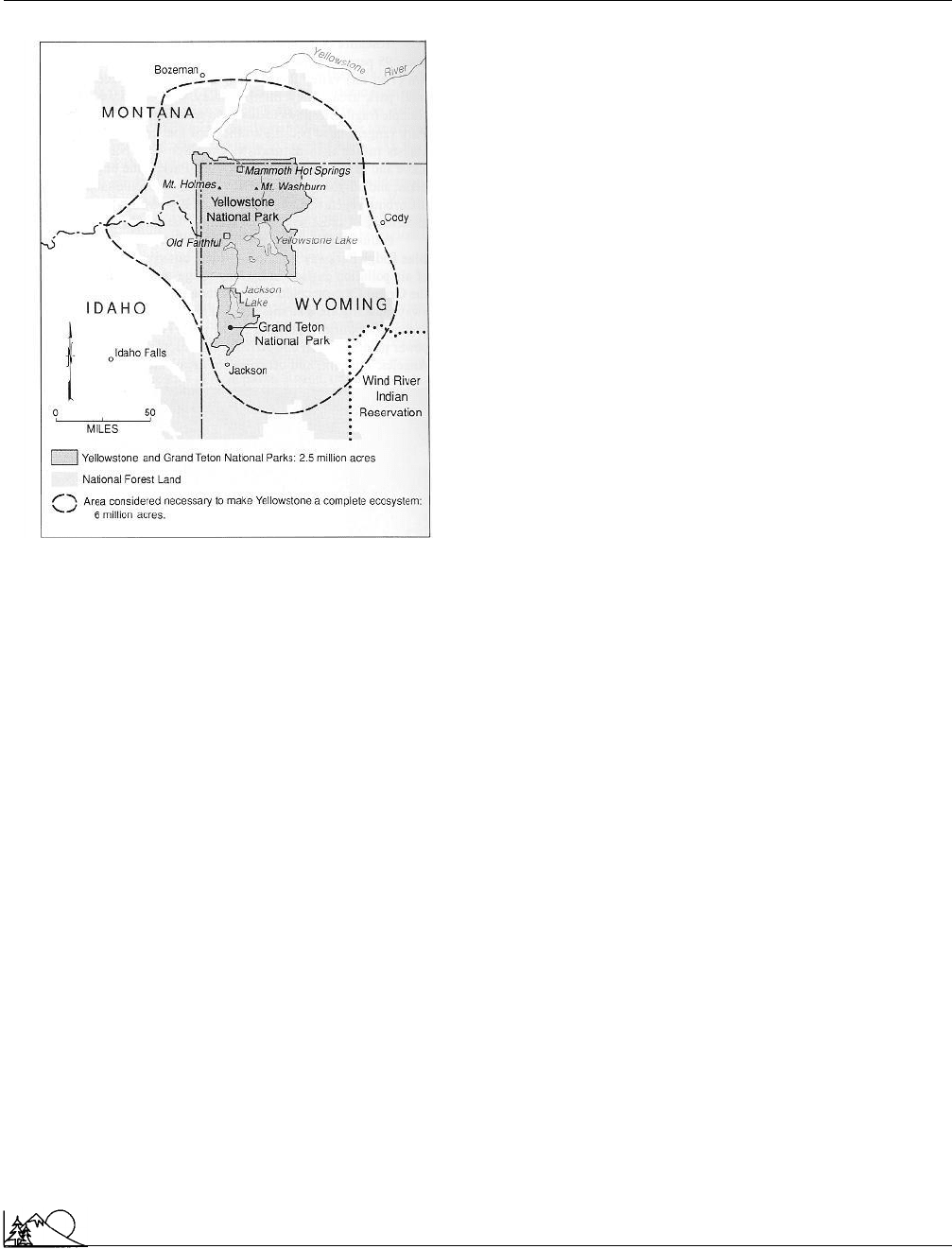Environmental Encyclopedia
Подождите немного. Документ загружается.


Environmental Encyclopedia 3
World Trade Organization (WTO)
activists, and organic farmers were among those who filled
the streets. They held teach-ins, workshops, and peaceful
marches with thousands of participants (sometimes de-
scribed as “turtles and teamsters"), but what got headline
coverage was civil disobedience including blocking streets,
unfurling banners from atop giant construction cranes, and,
for a few of the most radical anarchists, breaking windows,
setting fires in dumpsters, and looting stores. These destruc-
tive acts were condemned by mainstream groups, but got
most of the press anyway.
Unprepared for such a massive protest movement, the
police reacted erratically. Ordered to avoid confrontation on
the first day of the protests, the police stood by while a small
contingent of black-hooded anarchists smashed windows
and vandalized property. The next day, stung by criticism
of being too soft, the police used excessive force to clear the
streets, firing
rubber
bullets and tear gas indiscriminately,
spraying innocent bystanders with pepper spray, and club-
bing nonviolent groups engaged in passive sit-ins. The mayor
declared a civil emergency and a 24–hour curfew in the area
around the Civic Center. Eventually, the National Guard
was called in to assist the thousands of city police. As often
happens in confrontations, positions harden and violence
begets more violence.
Most of the people protesting in Seattle agreed that
the current WTO represents a threat to democracy, quality
of life,
environmental health
, social justice, labor rights,
and national sovereignty. Underneath these complaints is a
broader unease about trends towards globalization and the
power of transnational corporations. Although the diverse
band of protestors shared many concerns, many disagreed
about the best solutions to these problems and how to achieve
them. While many claimed they wanted to shut down the
WTO, others actually want a stronger trade organization
that can enforce rules to protect workers, environmental
quality, and
endangered species
.
In the end, the delegates adjourned without agreement
on an agenda for the “Millennium Round” of the WTO.
Developing countries, such as Malaysia, Brazil, Egypt, and
India, refused to allow labor conditions into the debate.
Major agricultural exporters such as the United States, Can-
ada, Argentina, and
Australia
, continued to demand an
end to crop subsidies and protective policies. Japan and the
European Union
(EU), on the other hand, maintain that
they have a right to preserve small, family farms, rural life-
styles, and traditional methods of food production against
foreign competition. Developing countries insist that protec-
tion of their
environment
and
wildlife
is no one’s business
but their own.
Following Seattle in 1999, activists have demonstrated
against the effects of globalization at a number of world
governance meetings. The most violent of these occurred in
1537
July 2001, when 100,000 protestors converged on a meeting
of the Group of Eight Industrialized Nations in Genoa,
Italy. As was the case in Seattle, the vast majority of the
demonstrators were peaceful and non-violent, but a small
group of radicals attacked police and vandalized property.
The police responded with what many observers considered
excessive force, killing one man and injuring hundreds of
others. Outrage at police behavior spread across Europe
as live television showed unprovoked attacks on peaceful
marchers and innocent bystanders.
In the aftermath of Genoa, both protestors and gov-
ernment officials began to re-examine their strategies for
future meetings. Leaders of many community groups ques-
tion whether they should take part in mass demonstrations,
because of both the personal danger and the negative image
resulting from association with marauding vandals. They
began to reflect on other ways to carry out their goals while
avoiding the violence that marred previous demonstrations.
Government officials announced that future meetings would
be held in remote, inaccessible locations that limit public
participation. The 2001 meeting of the WTO, for example,
was held in Qatar, an authoritarian country that strictly
forbids any form of public demonstration. Those who
weren’t official delegates to the meeting weren’t even allowed
into the country, perpetuating the image of the WTO as a
secretive and high-handed organization.
While the location and tactics of the debate about
globalization has changed, the basic problems remain. As
Renato Ruggiero, the former director-general of the WTO
once said, “We are no longer writing the rules of interaction
among separate national economies. We are writing the
constitution of a single global economy.” The politicians and
transnational corporations who currently control much of
direction of global governance dismiss their critics as an
irrelevant collection of environmental extremists and bleed-
ing-heart social activists who know nothing about economics
or practical politics. On the other hand, even World Bank
president, James D. Wolfensohn admits that “at the level
of people, globalization isn’t working.” We clearly need a
way to engage governments and others in a dialogue on how
we will organize global trade in an increasingly intercon-
nected world.
Interestingly, the organizational power of protest
groups in Seattle and elsewhere shows the growing interna-
tionalism of social movements and grass-roots organizations.
Internet technology, the declining cost of travel, and rising
educational levels have dramatically extended their capacity
to both think and act globally. Those who protest globaliza-
tion and argue for traditional, time-honored ways of doing
things are themselves using the technology and power of
global organization. Somehow we need to find a way to get
beyond “No.” How do we want to govern ourselves? How

Environmental Encyclopedia 3
World Wildlife Fund
will we respect local autonomy and culture, and still enjoy
the benefits that come from the increased flow of goods and
services across international borders?
[William P. Cunningham Ph.D.]
R
ESOURCES
B
OOKS
Gallagher, Peter. Guide to the WTO and Developing Countries. Boston, MA:
Kluwer Law International, 2000.
Howse, Robert. “Eyes Wide Shut in Seattle: The Legitimacy of the World
Trade Organization.” In The Legitimacy of International Institutions. United
Nations University Press, 2000.
Von Moltke, Konrad. Trade and the Environment: The Linkages and the
Politics. Winnipeg, Canada: International Institute for Sustainable Develop-
ment, 2000.
P
ERIODICALS
Cohn, Marjorie, ed. “Human Rights and Wrongs.” Guild Practitioner 57
(2000): 121.
Kovel, Joel. “Beyond the World Trade Organization.” Synthesis/Regenera-
tion 21 (2000): 6–9.
O
THER
“A Citizen’s Guide to the World Trade Organization: Everything You
need to know to Fight for Fair Trade.” Working group on the WTO. July
1997 [cited July 9, 2002]. <http://www.citizen.org>.
Anderson, Sarah, and John Cavanagh. “The World Trade Organization”
Foreign Policy in Focus. The Institute for Policy Studies.1997 [cited July 9,
2002]. <http://www.foreignpolicy-infocus.org/briefs/vol2/
v2n14wto.html>.
Murphy, Sophia. “Managing the Invisible Hand: Markets, Farmers and
International Trade” 2002. Institute for Agriculture and Trade Policy. [cited
July 9, 2002]. <http://www.tradeobservatory.org>.
Seattle Weekly Editors. “Answering WTO’s Big Questions: In a Nutshell,
What was WTO Seattle?” Seattle Weekly. August 3–9, 2000 [cited July 9,
2002]. <http://www.seattleweekly.com/features/0031/news-
editors.shtml>.
World Wildlife Fund
The World Wildlife Fund (WWF) is an international
con-
servation
organization founded in 1961, and known inter-
nationally as the World Wide Fund for Nature. The World
Wildlife Fund acts with other U.S. organizations in a net-
work to conserve the natural
environment
and ecological
processes essential to life. Particular attention is paid to
endangered species
and to natural habitats important for
human welfare. In hundreds of projects conducted or sup-
ported around the world, WWF helps protect endangered
wildlife and habitats and helps protect the earth’s
biodiver-
sity
through fieldwork, scientific research, institutional de-
velopment, wildlife trade monitoring, public policy initia-
tives, technical assistance and training,
environmental
education
, and communications.
WWF has articulated nine goals that guide its work:
1538
O
to protect habitat
O
to protect individual
species
O
to promote ecologically sound development
O
to support scientific investigation
O
to promote education in developing countries
O
to provide training for local wildlife professionals
O
to encourage self-sufficiency in developing countries
O
to monitor international wildlife trade
O
to influence public opinion and the policies of governments
and private institutions
Toward these goals, WWF monitors international
trade in wild plants and animals through its TRAFFIC
(Trade Records Analysis of Flora and
Fauna
in Commerce)
program, part of an international network in cooperation
with
IUCN—The World Conservation Union
. TRAFFIC
focuses on the trade regulations of the
Convention on Inter-
national Trade in Endangered Species of Wild Fauna
and Flora
(CITES), tracking and reporting on traded wild-
life species; helping governments comply with CITES provi-
sions; developing training materials and enforcement tools
for wildlife-trade enforcement officers; pressing for stronger
enforcement under national wildlife trade laws; and seeking
protection for newly threatened species.
Other recent WWF projects have included programs
to save the African elephant, especially through banning
ivory imports under CITES legislation. The organization
also has undertaken projects to preserve tropical rain forests;
to identify conservation priorities in the earth’s biogeograph-
ical regions; to halt overexploitation of renewable resources;
and to create new parks and wildlife preserves to conserve
species before they become endangered or threatened. Based
on WWF’s conservation efforts, The Charles Darwin Foun-
dation for the Galapagos Islands awarded WWF an institu-
tional seat on their Board of Directors.
WWF also funded a study of more than 2,000 projects
or activities reviewed by the U.S.
Fish and Wildlife Service
between 1986 and 1991. The study found that only 18 of
these projects were blocked or withdrawn because of detri-
mental effects to human populations. The study also showed
that the Northwest lost more timber jobs to automation of
timber cutting and milling, increased exports of raw logs,
and a shift of the industry to the Southeastern United States,
than it may lose from the listing of the
northern spotted
owl
(Strix occidentalis caurina) as an endangered species.
WWF has been credited with saving some 30 endan-
gered animal species from
extinction
, most notably the
gi-
ant panda
, which has become the group’s logo. Using
Geo-
graphic Information Systems
satellite technology, WWF
has identified regions where conservation of distinct animal
and plant species are most needed. By overlaying these areas
with existing parks and projects, WWF is able to see where

Environmental Encyclopedia 3
Charles Frederick Wurster
it needs to concentrate conservation programs. The organi-
zation publishes a wide variety of materials, including the
periodicals WWF Letter, TRAFFIC, and Tropical Forest Con-
servation. Booklets produced include “Speaker and News
Media Sourcebook: A Guide to Experts in Domestic and
International Environmental Issues,” for news media, poli-
cymakers, and organizations. Educational materials, research
papers, and books jointly published include The Gaia Atlas
of Future Worlds: Challenge and Opportunity in an Age of
Change (by Norman Myers); Options for Conservation: The
Different Roles of Nongovernmental Conservation Organiza-
tions (by Sarah Fitzgerald); WWF Atlas of the Environment
(By Geoffrey Lean, et al.); and The Official World Wildlife
Fund Guide to Endangered Species of North America. In 1996
the WWF produced a nationwide environmental program,
Windows on the Wild, for educators concerning the chal-
lenges of global conservation.
[Linda Rehkopf]
R
ESOURCES
O
RGANIZATIONS
World Wildlife Fund-U.S., 1250 12th Street, NW, Washington, D.C.
USA 20037, <http://www.worldwildlife.org>
Worldwatch Institute
Worldwatch Institute, a research organization based in
Washington, D.C., compiles and publishes information on
worldwide environmental problems; it also suggests solutions
and alternative courses of action. The Institute was founded
in 1975 by
Lester R. Brown
, with financial assistance from
the Rockefeller Brothers Fund. Brown is now its president
and director of research; chairman of the board is former
Secretary of Agriculture Orville Freeman. Membership is
$25 annually. The fee helps support the Institute’s research
and publications, which members receive, but there are no
avenues for membership participation within the Institute.
The Institute has published the State of the World
report annually since 1984; sales in recent years reached
$200,000. It is issued in 26 languages and is used as a
textbook in over 600 colleges in the United states alone.
The publication examines such topics as global warming,
water and
air quality
, and the environmental impact of
social policies. In 1990, State of the World was produced as
a 10-part series on public television, a joint venture with the
producers of Nova. The 1992 edition describes “a planet at
risk” and warned that “the policy decisions we make during
this decade will determine” the quality of life for
future
generations
.
Six to eight other Worldwatch papers are published
each year, and over a hundred monographs have been issued
1539
on specific subjects. Worldwatch magazine is published in
several languages, and the Environmental Alert series targets
particular environmental issues.
[Lewis G. Regenstein and Amy Strumolo]
R
ESOURCES
O
RGANIZATIONS
Worldwatch Institute, 1776 Massachusetts Ave., NW, Washington, D.C.
USA 20036-1904 (202) 452-1999, Fax: (202) 296-7365, Email:
worldwatch@worldwatch.org, <http://www.worldwatch.org>
WTO
see
World Trade Organization
Charles Frederick Wurster (1930 – )
American environmental scientist
Dr. Charles Wurster, a founding trustee of
Environmental
Defense
(formerly the Environmental Defense Fund, EDF),
was instrumental in banning the
pesticide
DDT. An emeri-
tus professor at the Marine Sciences Research Center at the
State University of New York at Stony Brook, Wurster is an
expert on the environmental effects of toxic
chemicals
.
Born in Philadelphia, Pennsylvania, Wurster’s interest
in birds was evident at a young age. He attended Quaker
schools—Germantown Friends and Haverford College—
receiving his bachelor’s of science degree in 1952. He earned
a master of science degree in chemistry from the University
of Delaware in 1954 and a Ph.D. in organic chemistry from
Stanford University in 1957. Subsequently Wurster spent a
year in Innsbruck, Austria, as a Fulbright Fellow. From 1959
to 1962, he worked as a research chemist at the Monsanto
Research Corporation.
In 1963, as a research associate in biology at Dart-
mouth College in New Hampshire, Wurster demonstrated
that the ubiquitous pesticide DDT was killing the campus
birds. DDT sprayed on elm trees killed 70% of the robins
in just two months. Myrtle warblers, who were not even on
the campus at the time of the spraying, also were killed, as
were all of the chipping sparrows. Furthermore DDT was
not saving the trees from fatal blight. Following a two-year
battle by Wurster and his colleagues, the local spraying of
DDT was halted.
After moving to Stony Brook in 1965 as an assistant
professor of biology, Wurster continued his studies on the
harmful effects of DDT. Among other results, he found
that high concentrations of DDT in Long Island osprey
were associated with thin eggshells and poor reproduction.
Much of his work was published in the prestigious journal
Science.

Environmental Encyclopedia 3
Charles Frederick Wurster
At Stony Brook, Wurster joined the Brookhaven
Town Natural Resources Committee, a group of scientists,
lawyers, and citizens. In one of the first-ever legal actions
to protect the
environment
, the committee forced Suffolk
County to stop spraying DDT for mosquito control in the
marshes of Long Island. In 1967 the committee incorporated
as the EDF. The EDF’s first major victory came with the
1972 nationwide ban on DDT, with Wurster in charge of
the scientific arguments. Wurster is credited with creating
a network of scientific expertise within the EDF that lent
credibility to the organization. In 1973, while on sabbatical
in New Zealand, Wurster helped found the Environmental
Defence Society (EDS), modeled on the EDF.
Wurster served as Associate Professor of Environmen-
tal Sciences at the Marine Sciences Research Center from
1970 until 1994 when he became an emeritus professor. His
research has focused on DDT,
polychlorinated biphenyls
(PCBs), and other
chlorinated hydrocarbons
, and their
effects on birds and
phytoplankton
(marine plants at the
base of the food web). He also has studied the
mortality
of diving birds caught on the longlines used for tuna fishing.
Wurster’s interest in the environmental sciences and public
policy has continued. He was instrumental in the banning
of the pesticides Dieldrin and Aldrin. In 1990 Wurster
assisted the U.S. Department of Justice in its legal case
against the Montrose Chemical Corporation, formerly the
world’s largest producer of DDT. The EDF first sued Mon-
trose in 1970 to stop it from dumping DDT into the Santa
Monica Bay. In 2000 Montrose, now owned by other com-
panies, was finally ordered to pay for the clean-up of 17 mi
2
(44 km
2
) of ocean floor. A fellow of the American Associa-
tion for the Advancement of Science, Wurster was a director
of
Defenders of Wildlife
from 1975 to 1984 and a trustee of
the
National Parks and Conservation Association
from
1970 to 1979. He continues as a director of the EDS.
From its beginnings as a small group meeting at the
Brookhaven National Laboratory, Environmental Defense
1540
has grown into one of world’s largest and most influential
environmental organizations, with 400,000 members and a
staff of 250 that includes scientists, economists, and lawyers.
Wurster continues to work with the EDF program for the
establishment of marine preserves in the United States and
in the open ocean and he leads ecological tours for the EDF.
[Margaret Alic Ph.D.]
R
ESOURCES
P
ERIODICALS
Mosser, J. L., N. S. Fisher, and C. F. Wurster. “Polychlorinated Biphenyls
and DDT Alter Species Composition in Mixed Cultures of Algae.” Science
176 (1972): 533–5.
Wurster, C. F. “Beetles and Dieldrin.” Science 163 (1969): 229.
Wurster, C. F. “DDT and Robins.” Science 159 (1968): 1413–4.
Wurster, C. F. “DDT Reduces Photosynthesis by Marine Phytoplankton.”
Science 159 (1968): 1474–5.
O
THER
Bowman, Malcolm J. “Charles Wurster: Environmental Hero and Advocacy
Pioneer.” EDS News, January 2002 [cited June 10, 2002]. <www.eds.org.nz/
News_Vol_4.htm>.
O
RGANIZATIONS
Dr. Charles F. Wurster, Marine Sciences Research Center, State University
of New York at Stony Brook, Stony Brook, NY USA 11794-5000 (631)
632-8738, Email: Charles.F.Wurster@stonybrook.edu,
Environmental Defence Society, PO Box 95 152 Swanson, Aukland, New
Zealand 1008 (64-9) 810-9594, Fax: (64-9) 810-9120, Email:
manager@eds.org.nz, <http://www.eds.org.nz>
Environmental Defense, 257 Park Avenue South, New York, NY USA
10010 (212) 505-2100, Fax: (212) 505-2375, Toll Free: (800) 684-3322,
Email: members@environmentaldefense.org, <http://www.environmental
defense.org>
WWF
see
World Wildlife Fund

X
X ray
Discovered in 1895 by German physicist Wilhelm K. Roent-
gen, x rays are a form of electromagnetic radiation, widely
used in medicine, industry, metal detectors, and scientific
research. X rays are most commonly used by doctors and
dentists to make pictures of bones, teeth, and internal organs
in order to find breaks in bones, evidence of disease, and
cavities in teeth.
Since x rays are a form of
ionizing radiation
, they
can be very dangerous. They penetrate into, and are absorbed
by, plants and animals and can age, damage, and destroy
living tissue. They can also cause skin burns, genetic muta-
tions,
cancer
, and death at high levels of exposure. The
effects of ionizing radiation tend to be cumulative, and every
dose adds to the possibility of further damage.
Some authorities feel that people should try to mini-
mize their exposure to such radiation and avoid being x-
rayed unless absolutely necessary. This is especially true of
pregnant women, since studies show a much higher rate of
childhood
leukemia
and other diseases among children who
were exposed to x rays in utero. Ironically, fear of malpractice
suits has prompted many doctors to increase the number of
x rays performed while examining patients for disease. See
also Radiation exposure
Xenobiotic
Designating a foreign and usually harmful substance or orga-
nism in a biological system. Xenobiotic, derived from the
Greek root xeno, meaning “stranger” or “foreign,” and bio,
meaning “life,” describes some toxic substances,
parasites
,
and symbionts. Food, drugs, and poisons are examples of
xenobiotic substances in individual organisms, and their tox-
icity is linked to the level of consumption. In communities
or
species
, xenobiosis happens when two distinct species,
such as different kinds of ants, share living space like nests.
At the
ecosystem
level, toxic waste, when bioaccumulated
1541
in the
food chain/web
, is xenobiotic. See also Bioaccumula-
tion; Hazardous waste; Symbiosis
Xeriscaping
see
Arid landscaping
Xylene
The term “xylene” refers to any of three
benzene
derivative
isomers that share the same chemical formula, C
6
H
4
(CH
3
)
2
,
but differ in their molecular structure. They are useful as
solvents, as additives to improve the
octane rating
of avia-
tion fuels, and as raw materials in the manufacture of fibers,
films, dyes, and other synthetic products. Because of their
high volatility they are classified as aromatic
hydrocarbons
(volatile compounds containing only
carbon
and
hydrogen
atoms). Xylene fractions were first isolated from
coal
tar in
the mid-nineteenth century in Germany. Coal tar is the
thick liquid product of the carbonization, or destructive dis-
tillation, of coal, a process in which coal is heated without
air to temperatures above 1,600°F (862°C). Benzene and
toluene
, two aromatic hydrocarbons similar to xylene, are
formed in the same process. Coal tar remained the source
for xylene until industrial demand outgrew the supply. Later,
techniques were developed to obtain xylene from
petroleum
refining, and today petroleum is a major source.
The three isomeric xylenes are classified by the ar-
rangement of the methyl (CH
3
) groups substituting for hy-
drogen atoms on the benzene ring. In each case, the methyl
groups replace two of the hydrogens attached to the six-
carbon benzene ring, but the structure and chemical proper-
ties of each isomer depend on which hydrogens are replaced.
Ortho-xylene (o-xylene) has methyl groups on two adjacent
carbons in the benzene ring structure, while in meta-xylene
(m-xylene) the methyl-containing carbons are separated by
a hydrogen-containing carbon. In para-xylene (p-xylene),
two hydrogen-bearing carbons separate the methyl-con-

Environmental Encyclopedia 3
Xylene
taining carbons, placing the methyl groups at opposite ends
of the molecule. Ortho-xylene, the least volatile of the three
forms, serves as raw material for the manufacture of coatings
and
plastics
. Para-xylene is used to manufacture polyesters.
Meta-xylene, less useful than the other forms, is used to make
coatings, plastics, and dyes. A commercial xylene mixture in
the form of a colorless, flammable, non-viscous, toxic liquid
is used as a solvent for lacquers and
rubber
cements. Emulsi-
fied xylene has been used as an economical and effective
way of controlling aquatic weeds in
irrigation
systems, but
concentrations must be carefully controlled to avoid harming
plants and fish exposed to the residues.
Xylene’s volatility leads to its easy escape into the
atmosphere
. Unless care is taken, its fumes soon permeate
the air in laboratories where it is used. Although its solubility
in water is quite limited, xylene (along with benzene and
toluene) is classified as one of the primary components of
the “water-soluble” fraction of petroleum. The widespread
use of xylene in manufacturing has resulted in significant
releases of the chemical into the air and water of the
environ-
ment
. Xylene’s toxicity in water is influenced by
salinity
,
1542
temperature, and the presence of other toxic materials. It
affects cell permeability and acts as a
neurotoxin
for fish
and other animals. At high concentrations of xylene, fish
exhibit a series of behavioral changes including restlessness
(rapid and erratic swimming), loss of equilibrium, paralysis,
and death. Although each of the three forms of xylene can
be detoxified by
microorganisms
, para-xylene is more diffi-
cult to detoxify, and therefore a more persistent threat.
[Douglas C. Pratt]
R
ESOURCES
B
OOKS
Buikema, L., and A. C. Hendricks. Benzene, Xylene, and Toluene in Aquatic
Systems: A Review. Washington, DC: American Petroleum Institute, 1980.
Hancock, E. G., ed. Toluene, the Xylenes, and Their Industrial Derivatives.
Amsterdam; New York: Elsevier, 1982.
Parmeggiani, L., ed. Encyclopaedia of Occupational Health and Safety. 3rd
ed. Geneva: International Labour Office, 1983.
Walsh, D. F., ed. Residues of Emulsified Xylene in Aquatic Weed Control
and Their Impact on Rainbow Trout, Salmo gairdneri. Denver, CO: U.S.
Dept. of the Interior [Bureau of Reclamation, Engineering and Research
Center, Division of General Research, Applied Sciences Branch], 1977.

Y
Yard waste
As the field of solid
waste management
becomes more
developed and specialized, the categories into which
solid
waste
is sorted and managed become more numerous. Yard
waste—often called vegetative waste—includes leaves, grass
clippings, tree trimmings, and other plant materials that are
typically generated in outdoor residential settings. De-
pending on the season and the neighborhood, leaves may
account for 5–30% of the total
municipal solid waste
stream, grass clippings may comprise 10–20%, and wood
may form about 5–10%. Yard waste does not include food
and animal wastes except possibly as impurities. Yard waste
is usually perceived as cleanest type of solid waste, in contrast
to household refuse or industrial and commercial trash.
Since yard waste is almost entirely vegetative in nature,
it lends itself easily to
composting
. Composting is the natu-
ral breakdown of organic matter by
microbes
, in the pres-
ence of oxygen, to form a stable end product called compost.
In the management of yard waste, this natural process de-
creases the need for
landfill
space and produces
soil
amend-
ment as an end product.
Beneficial use and composting of yard waste may be
practiced in the homeowner’s backyard or in the waste man-
agement areas set up by townships and municipalities. Not
all forms of yard waste lend themselves equally well to com-
posting. In fact, woody materials such as tree trunks may
be better managed and used by shredding into wood chips
or saw dust, since wood is very resistant to composting.
Leaves are most suitable for composting and provide the
richest and most stable base of material and nutrients. With
sufficient oxygen, water, and turnover, leaves can usually be
broken down in a matter of weeks. Grass clippings decom-
pose so quickly that they need to be mixed with slower-
degrading materials (such as leaves) in order to slow down
and regulate the rate of
decomposition
. Control over the
decomposition process is essential because of the potential
for problems such as noxious odors. If the decomposition
process is too rapid and proceeds without sufficient oxygen,
1543
the process becomes
anaerobic
and generates odors that
can be highly unpleasant. In seasons other than fall, when
the volume of leaves in yard waste is relatively small, many
experts recommend that grass clippings be used as
mulch
rather than as compost to avoid the potential for odor.
In urban and mixed
land use
neighborhoods, yard
waste may inadvertently contain
plastics
, papers, and other
non-degradable materials. In some areas, the bagging of yard
waste may involve the use of plastic bags. Depending on the
efficiency of separation at the waste management area, these
inert materials may find their way into the final compost
product and lower the esthetics and usefulness of the
compost.
[Usha Vedagiri]
R
ESOURCES
B
OOKS
Strom, P. F., and M. S. Finstein. Leaf Composting and Yard Waste Manage-
ment for New Jersey Municipalities. New Jersey Department of Environmen-
tal Protection and Energy, 1993.
Yellowstone National Park
Yellowstone National Park has the distinction of being the
world’s first
national park
. With an area of 3,472 sq mi
(8,992 sq km), Yellowstone is the largest national park in
the lower 48 states. This is an area larger than Rhode Island
and Delaware combined. Although primarily in Wyoming
(91%), 7.6% of the park is in Montana and the remaining
1.4% is in Idaho.
John Colter, a member of the Lewis and Clark expedi-
tion of 1803–1806, was probably the first white man to visit
and report on the Yellowstone area. At that time the only
Native Americans living year-round in the area were a mixed
group of Bannock and Shoshone known as “sheepeaters.” In
1859, the legendary trapper and explorer Jim Bridger, who
had been reporting since the 1830s about the wonders of the

Environmental Encyclopedia 3
Yellowstone National Park
A grizzly bear with its cubs in Yellowstone National Park. (National Park Service Harpers Ferry Center. Reproduced by
permission.)
region, led the first government expedition into the area. The
discovery of gold in the Montana Territory in the 1860s
brought more expeditions. In 1870, the Washburn-Lang-
ford-Doane expedition came to verify the reports about the
wonders of the area. They spent four weeks naming the fea-
tures, including Old Faithful, the most famous geyser in the
world. Legend states that while the 19 members of this expe-
dition sat around a campfire, reflecting on the beauty of the
area, they came up with the idea of turning the region into a
national park. The truth of the legend is debatable, yet there
is no doubt that it was the lecturing and writing of these men
that promptedthe United States
GeologicalSurvey
tosend a
follow-up groupto the park in 1871. Reportsand photographs
from the U.S. Geological Survey expedition stimulated the
drafting of legislation to create the first national park. Because
of the prevalent utilitarian philosophy and the country’s poor
economic condition, the battle for the park was difficult and
hard-fought. Eventually the park proponents were successful,
and on March 1, 1872, President Ulysses S. Grant signed the
bill establishing the park.
1544
Because Congress did not allocate any money for park
maintenance or protection, the early years of the park were
marked by vandalism,
poaching
, the deliberate setting of
forest fires, and other destructive behaviors. Eventually, in
1886, the U.S. Army took responsibility for the park. They
remained in the role of park managers until the
National
Park Service
was formed in 1916.
Water covers about 10% of the park. The largest body
of water is Yellowstone Lake, with a surface area of 136 sq mi
(352 sq km). It is one of the largest, highest, and coldest lakes
in North America. The park has one of the highest waterfalls
in the United States (Lower Yellowstone Falls, 308 ft; 93.87
m) and the top three trout fishing streams in the world. Ap-
proximately 10,000 thermal features can be found in the park.
In fact, there are more geysers (200–250) and hot springs in
the park than in the rest of the world put together.
The park has a great abundance and diversity of
wild-
life
. It has the largest concentration of mammals in the
lower 48 states. There are 58
species
of mammals in the
park, including two species of bears and seven species of

Environmental Encyclopedia 3
Yokkaichi asthma
Map of the Yellowstone ecosystem complex or
biogeographical region, which extends far be-
yond the boundaries of the park. (McGraw-Hill
Inc. Reproduced by permission.)
ungulates. It is one of the last strongholds of the
grizzly
bear
and is the only place where a
bison
herd has survived
continuously since primitive times. Yellowstone is noted
also for having the largest concentration of elk to be found
anywhere in the world. Besides mammals, the park is home
for 279 species of birds, 18 species of fish, five species of
reptiles, and four species of amphibians.
However, one of the continuing difficulties at Yel-
lowstone and other national parks is that Yellowstone is not
a self-contained
ecosystem
. Its boundaries were established
through a variety of political compromises, and lands around
the park that once provided a buffer against outside events
are being developed. Airsheds, watersheds, and animal
mi-
gration
routes extend far beyond park boundaries, yet they
dramatically affect conditions within the park. Yellowstone
is but one example of the need to manage entire biogeo-
graphical areas to preserve natural conditions within a na-
tional park.
[Ted T. Cable]
R
ESOURCES
B
OOKS
Frome, M. National Park Guide. 19th ed. Chicago: Rand McNally, 1985.
1545
O
THER
Yellowstone Fact Sheet. National Park Service, U.S. Department of Inte-
rior, 1992.
O
RGANIZATIONS
Yellowstone National Park, P.O. Box 168, Yellowstone National Park,
WY 82190-0168 (307) 344-7381, Email: yell_visitor_services@nps.gov,
<http://www.nps.gov/yell>
Yokkaichi asthma
Nowhere is the connection between industrial development
and environmental and human health deterioration more
graphically demonstrated than at Yokkaichi, Japan. An inter-
national port located on the Ise Bay, Yokkaichi was a major
textile center by 1897. The shipping business shifted to
nearby Nagoya in 1907, and Yokkaichi filled in its coastal
lowlands in a successful bid to attract modern industries,
especially chemical processing, steel production, and oil and
gasoline
refining.
Spurred by both the World War II demand and the
postwar recovery effort, several more
petrochemical
compa-
nies were added through the 1950s, creating an oil refinery
complex called the Yokkaichi Kombinato. In 1959 it began
24-hour operations, and the sparkle of hundreds of electric
lights became known as the “million-dollar night view.”
Although citizens took pride in the growing industrial com-
plex, their enthusiasm waned when
air pollution
and
noise
pollution
created human health problems. As early as 1953,
the central government sent a research group to try to dis-
cover the cause, but no action was taken. Instead, the petro-
chemical complex was expanded.
As citizens began to complain about breathing diffi-
culties, scientists documented a high correlation between
airborne
sulfur dioxide
concentrations and bronchial
asthma
in schoolchildren and chronic
bronchitis
in individ-
uals over 40. Despite this knowledge, a second industrial
complex was opened in 1963. In the Isozu district of Yokkai-
chi, the average concentration of sulfur dioxide was eight
times that of unaffected districts. Taller smokestacks spread
pollution
over a wider area but did not resolve the problem;
increased production also added to the volume discharged.
Despite
resistance
, a third industrial complex was added
in 1973, one of the largest
petroleum
refining and ethylene
producing facilities in Japan.
As the petrochemical industries continued to expand,
local citizens’ quality of life deteriorated. In the early years,
heavy
smoke
was emitted by
coal combustion
, and parents
worried about the exposure of schoolchildren whose play-
ground was close to the emissions source. Switching from
coal to oil in the 1960s seemed to be an improvement, but
the now-invisible stack gases still contained large quantities
of sulfur oxides, and more people developed
respiratory

Environmental Encyclopedia 3
Yosemite National Park
diseases
. By 1960, fish from the local waterways had devel-
oped such a bad taste that they were unsalable, and fishermen
demanded compensation for their lost livelihood. By 1961,
48% of children under six, 30% of people over 60, and 19%
of those in their twenties had respiratory abnormalities. In
1964, a pollution-free room was established in the local
hospital where victims could take refuge and breathe freely.
Even so, two desperate people committed suicide in
1966, and 12 Yokkaichi residents who had been trying to
resolve the problem by negotiation finally filed a damage
suit against the Shiohama Kombinato in 1967. In 1972, the
judge awarded the plaintiffs $286,000 in damages to be paid
jointly by the six companies. This was the first case in which
a group of Japanese companies were forced to pay damages,
making other kombinatos vulnerable to similar suits. As a
consequence of the successful litigation by the Yokkaichi
victims, the Japanese government enacted a basic antipollu-
tion law in 1967. Two years later, the Law Concerning
Special Measures for the Relief of Pollution-Related Patients
was enacted. It applied to chronic bronchitis/bronchial
asthma victims not only from Yokkaichi but also Kawasaki
and Osaka. In addition, national air-pollution standards were
strengthened to require that oil refineries adhere to air pollu-
tion abatement policies.
By 1975, the annual mean sulfur dioxide levels had
decreased by a factor of three, below the target level of 0.017
parts per million
(ppm). The harmful effects on residents
of Yokkaichi also decreased. In 1973, the Law Concerning
Compensation for Pollution-Related Health Damages and
Other Measures aided sufferers of chronic bronchitis and
bronchial asthma from the other affected areas of Japan,
especially Tokyo. By December 1991, 97,276 victims
throughout Japan, including 809 from Yokkaichi, were eligi-
ble for compensation. See also Air-pollutant transport; Envi-
ronmental law; Industrial waste treatment; Tall stacks
[Frank M. D’Itri]
R
ESOURCES
B
OOKS
Huddle, N., and M. Reich. Island of Dreams: Environmental Crisis in Japan.
Tokyo, Japan: Autumn Press, 1975.
P
ERIODICALS
Kitabatake, M., H. Manjurul, P. Feng Yuan, et al. “Trends of Air Pollution
Versus Those of Consultation Rate and Mortality Rate for Bronchial
Asthma in Individuals Aged 40 Years and Above in the Yokkaichi Region.”
Nihon Eiseigaku Zasshi 50, no. 3 (1995): 737.
O
THER
“Diseases By Air Pollution.” In Quality of the Environment in Japan. Tokyo,
Japan: Environmental Agency, Government of Japan, 1990.
1546
Yosemite National Park
Yosemite National Park is a 748,542-acre (303,160-ha) park,
located on the western slope of the Sierra Nevadas in north-
ern California. The name Yosemite comes from the name
of an Indian tribe, the U-zu-ma-ti, who were massacred in
1851 by soldiers sent by the governor of California for refus-
ing to attend a reservation agreement meeting.
By the mid-1800s, Yosemite had become a thriving
tourist attraction. As word of Yosemite’s wonders spread
back to the East Coast, public pressure led Congress to
declare that the Yosemite Valley and the Mariposa Grove
of giant sequoias be held “inalienable for all time.” President
Abraham Lincoln signed this law on June 30, 1864, turning
this land over to the state of California and thereby giving
Yosemite the distinction of being the first state park. Con-
cern about sheep
overgrazing
in the high meadows led to
the designation of the high country as a
national park
in 1890.
The person most strongly associated with the protec-
tion of Yosemite and its designation as a national park is
naturalist and philosopher
John Muir
. Muir, sometimes
called the “Thoreau of the West,” first came to Yosemite
in 1868. He devoted the next 40 years of his life to ensuring
that the
ecological integrity
of the region was maintained.
In 1892, Muir founded the
Sierra Club
to organize efforts
to gain national park status for the Yosemite Valley.
Yosemite National Park is famous for its awesome and
inspiring scenery. Geologic wonders include the mile-wide
Yosemite valley surrounded by granite walls and peaks such
as El Capitan (7,569 ft [2,307 m] above sea level; 3,593 ft
[1,095 m] from base) and Half Dome (8,842 ft [2,695 m]
above sea level; 4,733 ft [1,443 m] from base). Spectacular
waterfalls include Yosemite Falls (Upper 1,430 ft [436 m],
Middle 675 ft [206 m], Lower 320 ft [98 m]), Ribbon Falls
(1,612 ft [491 m]), Bridalveil Falls (620 ft [189 m]), Sentinel
Falls (2,001 ft [610 m]), Horsetail Falls (1,001 feet [305
meters]), and Vernal Falls (317 ft [97 m]).
The park supports an abundance of plant and animal
life. Eleven
species
of fish, 29 species of reptiles and am-
phibians, 242 species of birds, and 77 species of mammals
can be found in the park. There are approximately 1,400
species of flowering plants, including 37 tree species. The
most famous of the tree species found here is the giant
sequoia (Sequoiadendron giganteum). The park has three
groves of giant sequoias, the largest being the Mariposa
Grove with 500 mature trees, 200 of which exceed 10 ft (3
m) in diameter.
Because of the high degree of development and the
congestion from the large numbers of visitors (over four
million per year as of 2002), some have disparagingly referred
to the Valley as “Yosemite City.” Yosemite has become a
